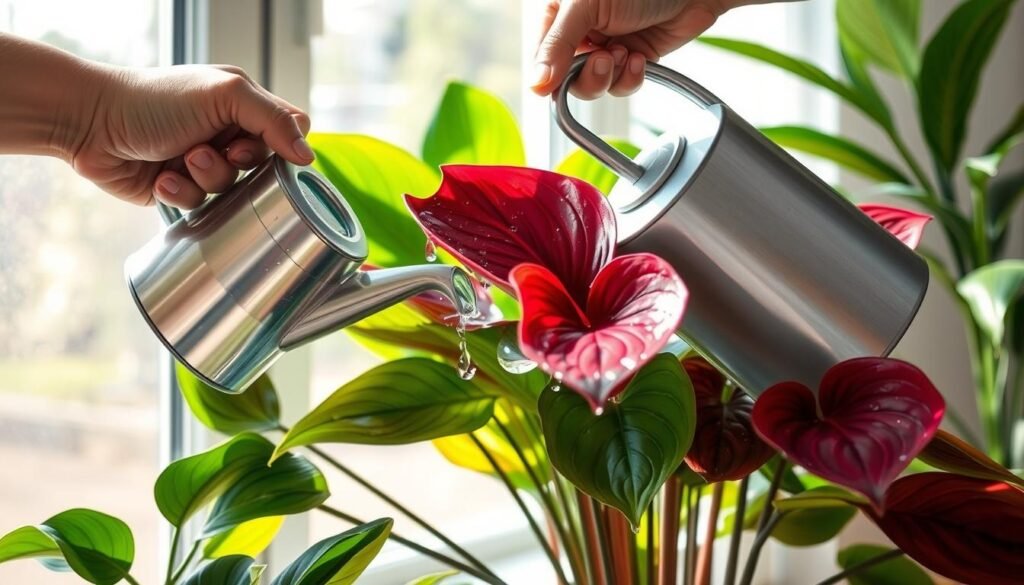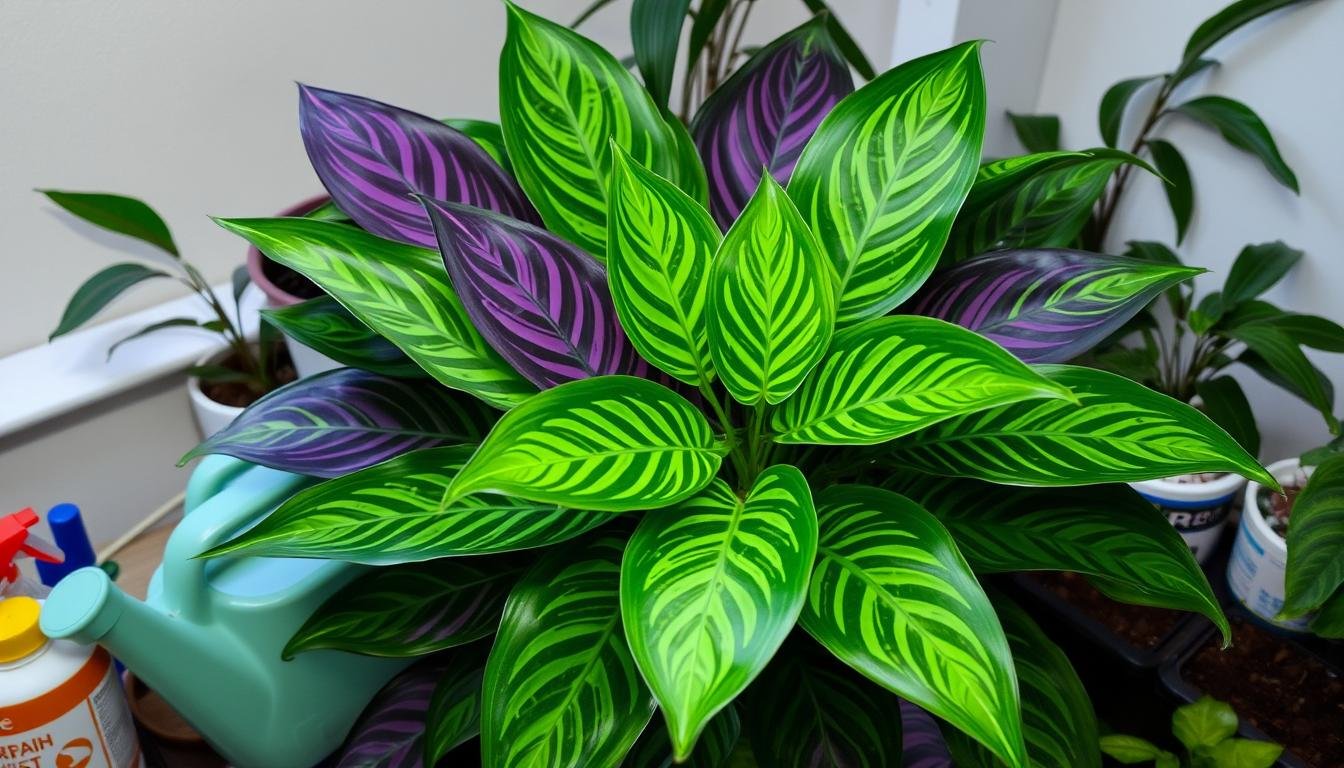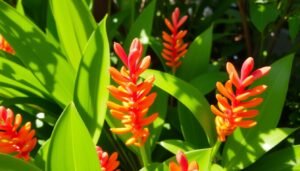The peacock plant, known as Calathea makoyana, is a great choice for indoor plants. It has beautiful tropical leaves that look like peacock feathers. If you want to add some exotic beauty to your home, learning how to care for this plant is key. This care guide will help you create the best environment for your plant, including the right light, humidity, and watering.
This plant loves warm, humid places, making it perfect for indoors. Even though it’s safe for pets, it needs careful care to stay healthy. By following these tips, your peacock plant can grow up to 15 inches tall and wide, adding beauty to your space for years.
Table of Contents
Introduction to the Peacock Plant
The peacock plant, known as Calathea makoyana, is a beautiful indoor plant. It comes from Brazil’s lush rainforests. Its leaves and colors are unique, making it stand out.
This plant grows 1 to 2 feet tall and spreads 8 to 12 inches wide. It fits well in many indoor spaces.
The peacock plant’s leaves are a mix of green, cream, and pink. Its stems and undersides are reddish-maroon and deep purple. This makes it a feast for the eyes.
When cared for right, this plant thrives. It can make your home feel more tropical and welcoming.
To keep a peacock plant healthy, it needs medium to bright indirect light. It prefers warm temperatures between 65 to 85 degrees Fahrenheit. The soil should be moist but not too wet to avoid root rot.
Before getting a peacock plant, know its special care needs. It can do well in many indoor spots. For more tips, check out gardening guides.
Understanding Calathea Makoyana and Its Characteristics
The Calathea makoyana, also known as the peacock plant, is a stunning tropical houseplant. It can grow up to 30 to 50 cm tall. Its leaves can reach 15 cm long.
The leaves are green with patterns that look like peacock feathers. The underside of the leaves is a beautiful red-purple color.
This plant loves shaded areas, making it perfect for indoor spaces with little light. It grows best in temperatures between 23 to 25 °C. It’s safe for pets, making it a great choice for homes.
In its natural habitat, it blooms with yellow flowers in January and February. This is rare indoors but shows the plant’s lively cycle. Its dense, lush look adds beauty to any room.

Knowing these key traits helps you care for your Calathea makoyana. Paying attention to its water, soil, and light needs keeps it looking vibrant. This way, it becomes a stunning centerpiece in your home.
Choosing the Right Location for Your Peacock Plant
Finding the perfect spot for your peacock plant is key to its health. It’s all about light and temperature. Peacock plants love humid, tropical places, just like their home.
Importance of Light Conditions
Peacock plants need medium to low, indirect light. Direct sunlight can hurt their leaves. A spot with filtered sunlight is best.
Without enough light, they won’t grow well. So, check how much natural light your spot gets.
Ideal Temperature Ranges
The right temperature is also vital. Peacock plants do best between 60 to 75 degrees Fahrenheit. Avoid drafts and extreme temperatures.
Stable temperatures help them grow strong. This is important for their health.

Soil Requirements for Thriving Peacock Plants
To make your peacock plant happy, knowing what soil it likes is key. The right mix helps roots grow strong and keeps the soil moist. This part will show you how to pick the best mix and keep the soil just right, which is vital for your plant’s health.
Choosing the Right Potting Mix
Your peacock plant does best in a mix that’s rich and drains well. A good mix usually has:
- Two parts regular houseplant potting soil
- One part sphagnum moss or coco coir
- One part perlite
This mix gives your plant the nutrients it needs and lets water drain off, preventing root rot. It’s important to avoid soil that’s too tight, as it can hurt your plant’s growth.
Maintaining Soil Moisture Levels
Keeping the right moisture is key for your peacock plant’s health. Check the soil by feeling its surface; it should be dry before you water again. Too much water can cause root rot, while too little can make leaves curl.
Remember:
| Condition | Indication |
|---|---|
| Underwatering | Curling or browning leaves |
| Overwatering | Yellowing leaves or root rot |
By following these soil tips and keeping the moisture right, your peacock plant will grow well and look great.

Watering Techniques and Best Practices
Proper watering is key for your Calathea, also known as the peacock plant. Knowing how to water right helps your plant grow well. Use filtered, room temperature water to avoid harming it with chemicals.
It’s vital to water correctly to keep the right moisture. This prevents damage to your plant.
Signs of Underwatering vs. Overwatering
It’s important to know when your peacock plant needs more or less water. If leaves curl and the soil is dry, it’s underwatered. This means it needs more moisture.
But, too much water can cause root rot. Look for yellow leaves and soggy soil to spot this. Knowing these signs helps you water better.
Using Filters for Water Quality
Water quality is important for your peacock plant’s health. Using filters can improve water quality by removing harmful chemicals. This creates a better environment for your plant.
Regularly check your watering methods. This helps keep your peacock plant healthy and thriving for a long time.

Humidity: Key to Healthy Peacock Plants
Humidity is key for your peacock plant’s health. It loves humid environments, needing at least 60% humidity. Learning to manage humidity will boost your indoor garden’s health and energy.
Methods to Increase Humidity
There are several ways to make your peacock plant’s environment more humid. Here are some effective methods:
- Misting: Spritz the leaves now and then to boost humidity.
- Humidifiers: Use a humidifier in the room to keep moisture steady.
- Pebble Trays: Put a tray with pebbles and water under the pot. As water evaporates, it raises local humidity.
Effects of Low Humidity on Leaf Health
Low humidity can harm your plant’s leaves. You might see:
- Browning tips on leaves.
- Curling leaves that show stress.
- Leaves that droop, affecting the plant’s overall health.
Keeping humidity high is good for your plants and your home. For tips on keeping your peacock plants healthy, check out this source.
| Humidity Level | Effect on Plant |
|---|---|
| Less than 40% | Leaf curling and browning |
| 40% – 60% | Stress on leaf health, moderate growth |
| 60% and above | Optimal growth and vibrant leaves |
Feeding Your Peacock Plant for Optimal Growth
Feeding your plants is key to their health and beauty. Peacock plants, like Calathea makoyana, need the right food and schedule. Feed them regularly from spring to fall for the best growth.
Recommended Fertilizers and Schedules
Use a diluted liquid fertilizer every two weeks for best results. This gives your plant the nutrients it needs for strong leaves. Choose a balanced fertilizer with nitrogen, phosphorus, and potassium. Organic fertilizers also improve soil quality.
Signs of Nutrient Deficiencies
Nutrient deficiencies can happen even with regular feeding. Spotting these signs early is important. Look out for:
- Yellowing Leaves: This means your plant needs more nitrogen.
- Stunted Growth: If your plant isn’t growing, it might need more nutrients.
- Brown Tips on Leaves: This could mean a potassium problem or low humidity.
Pay attention to these signs to keep your peacock plant healthy. Regular feeding keeps it strong and colorful. For more tips, check out this guide.
| Signs of Nutrient Deficiencies | Possible Nutrient | Suggested Action |
|---|---|---|
| Yellowing Leaves | Nitrogen | Increase nitrogen-rich fertilizer |
| Stunted Growth | General Nutrient Deficiency | Use a balanced fertilizer |
| Brown Tips on Leaves | Potassium or Low Humidity | Check humidity levels; adjust feeding |
Pruning and Maintenance of Your Peacock Plant
To keep your peacock plant healthy, regular pruning and care are key. Pruning encourages growth and keeps the plant looking neat. Remove dead or damaged leaves and fix browning tips. Prune in the fall and winter when the plant is dormant.
Regular care is vital for your plant’s health. It helps with new growth and keeps pests away. Check your plant often for any problems. Here’s a care checklist:
| Task | Frequency | Notes |
|---|---|---|
| Pruning dead or damaged leaves | Monthly | Snip leaves at the base of the stem. |
| Watering | Weekly | Water when the top inch of soil is dry. |
| Misting | As needed | Helps maintain humidity, mainly in dry conditions. |
| Repotting | Every 12-18 months | Use a well-draining potting mix. |
| Pest inspection | Biweekly | Look for signs of pests and apply neem oil if needed. |
Good peacock plant care practices are essential. Watch for signs like curling leaves needing water or brown tips from environmental issues. These tips will help keep your plant looking great.
Consistent care and pruning are vital for your plant’s beauty. Follow these tips to help your plant thrive.
For more plant care tips, visit this page to improve your gardening skills.
Propagation Techniques for Peacock Plants
Propagating peacock plants, like the Calathea species, lets you grow more plants or share them with friends. The main method is dividing. This is best done in spring or summer when the plant is most active.
Dividing and Repotting Strategies
Start by watering your peacock plant a few days before dividing. This softens the soil and makes it easier to handle. The best temperature for dividing is between 60 to 70 degrees Fahrenheit (16-21 degrees Celsius).
When ready to divide, gently remove the plant from its pot. Use your hands or a sterilized knife to separate the roots. Make sure each division has enough roots to grow well. Use a good potting mix that keeps moisture but also drains well.
After repotting, give your new plants the right care. Use a diluted nitrogen fertilizer every two weeks to once a month. This helps them grow and keeps their leaves looking good. You’ll see results in a few weeks.
Dividing and repotting not only helps your plants but also lets you grow new ones. Remember, Calathea plants need humidity. For more tips on caring for your plants, check out this comprehensive care guide.
| Propagation Technique | Best Time | Key Tips |
|---|---|---|
| Dividing | Spring or Summer | Water a few days prior, ensure divisions have sufficient roots. |
| Repotting | After dividing | Use quality potting mix, maintain humidity. |
| Nitrogen Fertilizer | Every 2-4 weeks post-repotting | Use half-strength for young divisions. |
Common Challenges and Solutions
The peacock plant is beautiful but faces challenges that can harm its health. Quick action to these problems can help keep your plant looking great. It’s key to know about pests and diseases to keep your plant thriving.
Pest Management Tips
Pests like red spider mites and fungus gnats can harm your peacock plant. They love dark, moist places. To keep your plant healthy, use these pest management tips:
- Neem oil: Neem oil fights pests naturally.
- Regular inspections: Check your plant often for pests to catch them early.
- Proper sanitation: Keep the area around your plant clean to stop pests.
- Optimal humidity: Keep humidity between 50-60% to keep pests away.
Identifying and Treating Diseases
Diseases can be big problems for your peacock plant. Signs like wilting or yellow leaves mean something’s wrong. Spotting these signs early is key to fixing the problem. Here are some important things to remember:
- Underwatering and overwatering: Both can make leaves droop or turn yellow. It’s about finding the right balance.
- Transplant shock: Moving your plant can shock it. Keep conditions stable to help it recover.
- Root rot: Too much water can rot the roots. Use a potting mix that drains well to avoid this.
- Sun exposure: Too much sun can hurt the leaves. Bright, filtered light is better for growth.
Conclusion
In this guide, we’ve covered key points for peacock plant care. These points help your Calathea Makoyana stay healthy and vibrant. From picking the right spot to knowing their soil and humidity needs, every step is important.
Regular upkeep and watching the environment are key. This helps avoid problems like droopy leaves or pests. So, you can enjoy their beautiful leaves in your home.
For the best care, use the right watering, fertile soil, and humidity. Adding fertilizer monthly during growth seasons boosts their health. If you want more plants, try growing them from cuttings. This can make your home feel like a jungle.
By caring for your peacock plant well, it will grow and even clean the air in your home. Following this guide will help you create a lush, thriving space. For more tips, check out additional resources on plant care.



